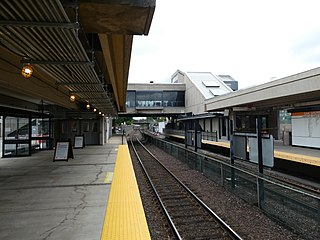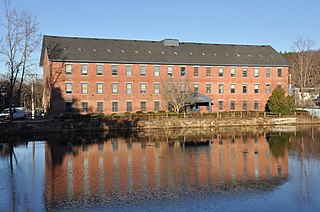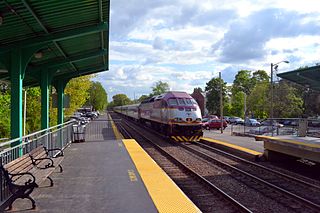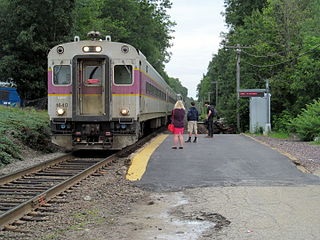
Anderson Regional Transportation Center (RTC) (noted on MBTA schedules and maps as Anderson/Woburn, and on Amtrak schedules and maps as Woburn–Anderson) is a train and bus station located at 100 Atlantic Avenue, off Commerce Way, in Woburn, Massachusetts, a suburb of Boston. It can be accessed from Exit 30 off Interstate 93 or Exit 54 (Washington Street) from southbound Interstate 95/Route 128.

The MBTA Commuter Rail system serves as the commuter rail arm of the Massachusetts Bay Transportation Authority's (MBTA's) transportation coverage of Greater Boston in the United States. Trains run over 394 mi (634 km) of track to 134 stations. It is operated under contract by Keolis, which took over operations on July 1, 2014, from the Massachusetts Bay Commuter Railroad Company (MBCR).

Oak Grove station is a Massachusetts Bay Transportation Authority (MBTA) intermodal transit station in the northern section of Malden, Massachusetts, just south of the Melrose border. It is the northern terminus of the rapid transit Orange Line and a stop on the Haverhill Line commuter rail service. The accessible station has a 788-space park and ride lot and is served by three MBTA bus routes.

Malden Center station is a Massachusetts Bay Transportation Authority (MBTA) intermodal transit station in Malden, Massachusetts. Located on an elevated grade above Pleasant Street in downtown Malden, it serves the rapid transit Orange Line and the MBTA Commuter Rail Haverhill Line. The station has one island platform for the two Orange Line tracks and a single side platform for the single commuter rail track. Two busways are used by 12 MBTA bus routes.

The Lowell Line is a railroad line of the MBTA Commuter Rail system, running north from Boston to Lowell, Massachusetts. Originally built as the New Hampshire Main Line of the Boston & Lowell Railroad and later operated as part of the Boston & Maine Railroad's Southern Division, the line was one of the first railroads in North America and the first major one in Massachusetts.

Ballardvale is a village located within the boundaries of the town of Andover, Essex County, Massachusetts, United States. Growing originally in the 19th century around mills located on the Shawsheen River, the village is a local historic district, boasting many varieties of historic architecture and a rich industrial heritage.
The Haymarket North Extension is a section of the Massachusetts Bay Transportation Authority's rapid transit Orange Line which currently constitutes the northern section of the line. It runs from North Station through an underground crossing of the Charles River, then along the Haverhill Line right-of-way to Oak Grove station in Malden, Massachusetts. Built to replace the Charlestown Elevated and originally intended to be extended as far as Reading, it opened in stages between 1975 and 1977.

Haverhill station is an intercity and regional rail station located in downtown Haverhill, Massachusetts, United States. It is served by Amtrak's Downeaster service and the MBTA Commuter Rail Haverhill/Reading Line; it is the northern terminus of MBTA service on the line. Haverhill is one of two major hubs for MVRTA local bus service; the Washington Square Transit Center is located 1⁄5 mile (0.32 km) east of the rail station.

Wyoming Hill station is an MBTA Commuter Rail station on the Haverhill Line, located in Wyoming Square near downtown Melrose, Massachusetts. The station has two low-level side platforms and is not accessible. Wyoming Hill, in addition to the two other commuter rail stops in Melrose, was originally intended to be an extension of the Orange Line further north to Reading, Massachusetts.

Melrose/Cedar Park station is an MBTA Commuter Rail station located in downtown Melrose, Massachusetts. The station has two low-level platforms serving the two tracks of the Haverhill Line; it is not accessible.

Melrose Highlands station is an MBTA Commuter Rail station on the Haverhill Line located in the Melrose Highlands neighborhood of Melrose, Massachusetts. It is the most used station in the city, and was originally planned to be a station on the cancelled extension of the Orange Line to Reading. The station is accessible.

Wilmington station is an MBTA Commuter Rail station in Wilmington, Massachusetts served by the Lowell Line. It is located near the intersection of Main Street and Church Street in Wilmington's town center. The station is accessible, with mini-high platforms serving both tracks.

The Senator Patricia McGovern Transportation Center, also known as the McGovern Transportation Center or simply Lawrence station, is a transit station in Lawrence, Massachusetts. It serves the MBTA Commuter Rail Haverhill Line and Merrimack Valley Regional Transit Authority local bus service. The station, which opened in 2005, is the latest of seven distinct stations located in Lawrence since 1848; it is located in the city's Gateway District.

Andover station is an MBTA Commuter Rail station in Andover, Massachusetts. It serves the Haverhill Line. The station has one platform with a mini-high platform for handicapped accessibility serving one track, while the second track lacks a platform. The previous station building, used from 1907 to 1959, is still extant; it was added to the National Register of Historic Places in 1982 as Third Railroad Station.

Bradford station is an MBTA Commuter Rail station in the Bradford neighborhood of Haverhill, Massachusetts, served by the Haverhill Line. The Haverhill Line's layover yard is located adjacent to the station.

Reading station is an MBTA Commuter Rail station in Reading, Massachusetts. It serves the Haverhill/Reading Line. It is located at Lincoln and High Streets on the western fringe of Reading's central business district. The station's historic depot building was built in 1870 by the Boston and Maine Railroad. The station was the terminus of the line from 1959 until the re-extension to Haverhill station in 1979.

North Wilmington station is an MBTA Commuter Rail station in North Wilmington, Massachusetts. It serves the Haverhill Line, and is located off Middlesex Avenue (Route 62). It has some of the most limited station faculties on the MBTA system – a single short non-accessible platform serving the line's single track at the location, with a small parking lot and shelter for passengers. North Wilmington served by most Boston–Haverhill trains except for a small number that use the Wildcat Branch. It is a flag stop except during weekday peak hours.

Ballardvale station is an MBTA Commuter Rail station on the Haverhill Line, located in the Ballardvale village of Andover, Massachusetts. The station has a single side platform serving a single track.

The Wildcat Branch is a single track railroad branch line which connects the MBTA Lowell Line in Wilmington, Massachusetts to the MBTA Haverhill Line at Wilmington Junction. The total length of the branch line from the connection with the Lowell Line to the merge with the Haverhill Line is 2.88 miles (4.63 km). It was operated from 1836 to 1848, then rebuilt in 1874, and has been used since.

Salem Street station was a short-lived commuter rail station in Wilmington, Massachusetts in use from 1959 to 1967. It was located at the Salem Street crossing. It was established by the Boston and Maine Railroad (B&M) as the sole stop on the Wildcat Branch, in the wake of a restructuring brought on by service cuts. In 1965, the Massachusetts Bay Transportation Authority started funding MBTA Commuter Rail service on the B&M routes, but closed Salem Street in 1967.























